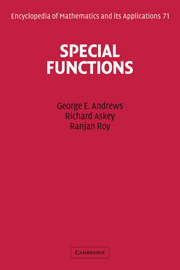Book contents
- Frontmatter
- Contents
- Preface
- 1 The Gamma and Beta Functions
- 2 The Hypergeometric Functions
- 3 Hypergeometric Transformations and Identities
- 4 Bessel Functions and Confluent Hypergeometric Functions
- 5 Orthogonal Polynomials
- 6 Special Orthogonal Polynomials
- 7 Topics in Orthogonal Polynomials
- 8 The Selberg Integral and Its Applications
- 9 Spherical Harmonics
- 10 Introduction to q-Series
- 11 Partitions
- 12 Bailey Chains
- A Infinite Products
- B Summability and Fractional Integration
- C Asymptotic Expansions
- D Euler–Maclaurin Summation Formula
- E Lagrange Inversion Formula
- F Series Solutions of Differential Equations
- Bibliography
- Index
- Subject Index
- Symbol Index
2 - The Hypergeometric Functions
Published online by Cambridge University Press: 05 May 2013
- Frontmatter
- Contents
- Preface
- 1 The Gamma and Beta Functions
- 2 The Hypergeometric Functions
- 3 Hypergeometric Transformations and Identities
- 4 Bessel Functions and Confluent Hypergeometric Functions
- 5 Orthogonal Polynomials
- 6 Special Orthogonal Polynomials
- 7 Topics in Orthogonal Polynomials
- 8 The Selberg Integral and Its Applications
- 9 Spherical Harmonics
- 10 Introduction to q-Series
- 11 Partitions
- 12 Bailey Chains
- A Infinite Products
- B Summability and Fractional Integration
- C Asymptotic Expansions
- D Euler–Maclaurin Summation Formula
- E Lagrange Inversion Formula
- F Series Solutions of Differential Equations
- Bibliography
- Index
- Subject Index
- Symbol Index
Summary
Almost all of the elementary functions of mathematics are either hypergeometric or ratios of hypergeometric functions. A series Σcn is hypergeometric if the ratio cn+1/cn is a rational function of n. Many of the nonelementary functions that arise in mathematics and physics also have representations as hypergeometric series.
In this chapter, we introduce three important approaches to hypergeometric functions. First, Euler's fractional integral representation leads easily to the derivation of essential identities and transformations of hypergeometric functions. A second-order linear differential equation satisfied by a hypergeometric function provides a second method. This equation was also found by Euler and then studied by Gauss. Still later, Riemann observed that a characterization of second-order equations with three regular singularities gives a powerful technique, involving minimal calculation, for obtaining formulas for hypergeometric functions. Third, Barnes expressed a hypergeometric function as a contour integral, which can be seen as a Mellin inversion formula. Some integrals that arise here are really extensions of beta integrals. They also appear in the orthogonality relations for some special orthogonal polynomials.
Perceiving their significance, Gauss gave a complete list of contiguous relations for 2F1 functions. These have numerous applications. We show how they imply some continued fraction expansions for hypergeometric functions and also contain three-term recurrence relations for hypergeometric orthogonal polynomials. We discuss one case of the latter in this chapter, namely, Jacobi polynomials.
Information
- Type
- Chapter
- Information
- Special Functions , pp. 61 - 123Publisher: Cambridge University PressPrint publication year: 1999
Accessibility standard: Unknown
Why this information is here
This section outlines the accessibility features of this content - including support for screen readers, full keyboard navigation and high-contrast display options. This may not be relevant for you.Accessibility Information
- 1
- Cited by
